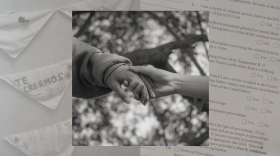Although I take public transportation all the time when I’m in New York, I hadn't been on a Milwaukee bus since I got my driver's license at 16. But half a century later, I’m old enough to get a discounted fare again, so when work took me downtown on a regular basis last winter, I decided to bury my old prejudices and take the bus.
That was when I discovered the zen of riding the bus.
Riding the bus is an entirely different experience from driving. You don’t have to keep an eye out for potholes or pedestrians, you don’t have to wonder why your car is making that funny noise, and except for your choice of a seat, things are completely out of your control, so you might as well just relax and enjoy the ride.
Once you leave the house, you are either going to get to the bus stop before the bus comes, or you aren’t. If you miss it, you just have to wait for the next one. Once aboard, nothing you can do can make it go any faster. Relinquishing control is not easy after a lifetime behind the wheel, but I adapted surprisingly quickly.
The morning buses in Milwaukee come fairly frequently. The evening buses are another story entirely. They don’t seem to adhere to any particular schedule, and standing at the bus stop, there was nothing I could do to make my bus show up. I found that I needed to adopt a totally different attitude, reminding myself, like a mantra, “It is out of my hands.” So once on board, I would read, or I might doze a bit-- not recommended when you’re the driver-- or just watch people watch the "street theater" for its entertainment value.
What entertainment? There was the guy who looked like Santa Claus out of season, long white hair and beard, huge belly-- but rather unwashed looking, someone I was particularly glad was sitting across from me rather than beside me.
There was another man, as wide as he was tall, who got on every morning and rode just three stops. Why, I wondered, hadn’t it occurred to him to walk those seven blocks and burn those calories?
Then there was the woman who talked-- loudly-- on her phone for most of one ride. Whoever was on the other end couldn't possibly have been saying anything, because this woman never stopped to breathe. But I can tell you a lot about her, including the fact that she makes $9.50 an hour. I guess people on cell phones forget that they're out in public. Or perhaps they are so comfortable on the bus that they don't realize they aren't at home.
Most people on the bus are quiet and respectful of others. A lot of them text, and some of them answer their phones but keep the conversations low volume and brief. Many people listen to i-pods though earphones-- the days of Star Trek IV, when Mr. Spock had to use a Vulcan nerve pinch to get another passenger to shut off his boom box are long gone.
One woman did have an argument-- over the course of many blocks-- with her mother on her cell phone. Then, apparently upset by it, she left her phone behind her when she disembarked. (Another passenger handed it to the driver).
There is a sign in the front of each bus that says that the front seven seats, most of which face sideways, must be vacated for seniors and the handicapped. Being a senior now, I usually sit in those seats, because I like to exit from the front.
That’s because the new buses "kneel" at the front. They make a beeping noise while the driver lowers the steps so you can climb aboard more easily. If you are there with a scooter or wheelchair, the driver can flip a ramp out after the bus kneels, and you can ride right on.
Most people vacated the front seats when they saw someone with a cane or white hair headed towards them. But one morning I discovered that even seniors aren’t always privileged. Those side-facing seats at the front fold up, so that people on handicapped scooters can park them there. When they board, the bus driver asks anyone sitting there to move, then raises the seat, lets the person park the scooter in the now-empty space, and then anchors the scooter with a mini seat belt located near the floor. Once, when there were two scooters on the bus at the same time, both side-facing seats had to be flipped up, and those of us who normally sat in front had to find places elsewhere on the bus.
If you are so inclined, you can ride your bike to the bus stop and take it with you to your destination. There is a rack on the front of the bus where bikes can be secured. Up to two bikes can be stored there. If you can’t get your bike into the rack, the driver will come out and help you.
I noticed that people sometimes get on the bus with numerous packages, obviously having been shopping. Often they get on with grocery bags. Indeed, the bus driver on the number 10 route actually calls out "Pick'n Save" rather than the street names when he gets to Humboldt and Garfield, where a large grocery store by that name is located.
People with babies and collapsible strollers ride the bus, as do those with young children in tow, or with slightly older ones who race to get the seat of their choice. On my route, several mornings a week, a boy of about eleven or twelve would get on, juggling his violin and backpack while holding the hand of a much younger boy who looked so much like him that it had to be his little brother. Sometimes there was another boy with them, about the little brother’s age, both of them carrying backpacks and sometimes dragging a cloth grocery bag as well. The older boy did yeoman service shepherding them onto the bus, through the ride, and off the bus-- with all their gear-- at their stop.
Decades ago, when last I rode the bus regularly, I don’t remember people thanking the bus driver as they got off, but everyone seems to do that now. Most bus drivers are very polite and considerate. So you thank them as you leave, and they tell you to have a nice day or evening. I like that exchange. It makes you feel good. When was the last time commuting by car did that?
On snowy days last winter, the bus was a cozy island of people commiserating about the weather. When it is dark outside as you board or get off, the bus feels like an island in the darkness, a kind of refuge from the world.
When the days became longer and it was still light when I left downtown, I discovered that my bus crossed the river twice-- at Water and Wisconsin and again at Humboldt. I think the Milwaukee County Transit System should have water buses-- in Venice, they call that a vaporetto. You could ride up the river and transfer at the points the bus route crosses it. I think it could be a tourist attraction, and in a warm winter like the one we had this year, it could probably operate throughout the year. Or perhaps, to allow for the weather, it could be scheduled only during the months when Daylight Savings Time was in effect, the way the downtown trolley only operates during summer months.
I think it would be great to commute on a water bus on the river. It would be a different kind of zen, but it would put nice parentheses around your work day. Come to think of it, so does the bus.





